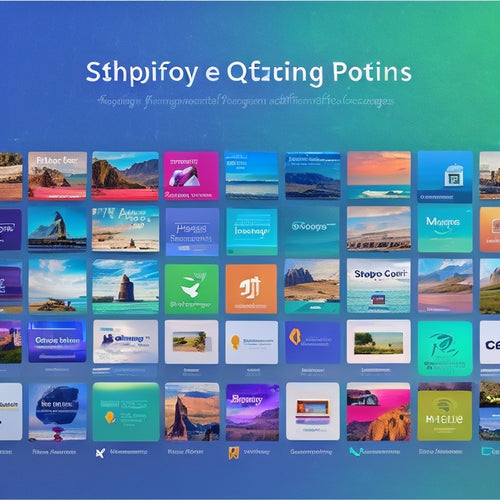
Mastering Digital Sales: Tips & Comparisons
Share
You're probably leaving money on the table by not fully harnessing the potential of digital sales, where products can be developed and distributed instantly, with minimal overhead costs, and reached a global audience with ease. To master digital sales, you need to understand your products and platforms, craft pricing and marketing strategies that resonate with your audience, and consider the pros and cons of digital vs physical products. By refining your branding and content creation strategy, you'll be on your way to creating and distributing successful digital products. Now, take the next step to reveal the secrets to maximizing your digital sales potential.
Key Takeaways
• Master digital sales by understanding your target audience's preferences and creating products that resonate with them.
• Choose the right distribution platform, considering factors like ease of use, payment gateways, and customer engagement.
• Develop pricing and marketing strategies that align with customer psychology and perceived value.
• Evaluate the advantages and drawbacks of digital versus physical products to make an informed decision for your business.
• Focus on customer engagement, track success metrics, and refine your branding and content strategy to ensure long-term success.
Understanding Digital Products
As you venture into the world of online sales, understanding the fundamental concept of digital products is essential. These products are intangible assets that can be sold and distributed online, providing a unique set of benefits and opportunities.
You'll need to take into account market preferences and online accessibility to make sure your products reach the right audience. One major advantage of digital products is immediate delivery, which eliminates the need for physical shipping and storage. This also means cost efficiency, as you won't have to worry about production and distribution costs.
Product Types and Platforms
You'll find a vast array of digital product types that cater to diverse customer needs, from practical resources like tiny house plans and language courses to creative assets like stock images and audio tracks.
To tap into niche markets, consider creating online courses or ebooks on self-publishing platforms. These products can be easily distributed through platforms like Easy Digital Downloads, Gumroad, or Shopify.
When choosing a platform, consider factors like ease of use, customization options, and payment gateways. You can create these products yourself or hire professionals to help.
With the right platform and product, you'll be well on your way to reaching your target audience and generating sales.
Pricing and Marketing Strategies
With your digital product ready for distribution, the next step is to develop a pricing and marketing strategy that resonates with your target audience and sets your product up for success.
You'll need to take into account pricing tactics that align with customer psychology, considering factors like perceived value and willingness to pay.
Online promotions can be an effective way to drive sales, but be mindful of the branding impact - make sure your promotions align with your overall brand message.
Selling Digital Vs Physical
When deciding which type of product to sell, digital or physical, considering the distinct advantages and drawbacks of each is essential in determining which best aligns with your business goals and target audience's preferences.
You'll want to weigh the benefits of digital products, such as quick creation and low costs, against the tangible quality of physical products, which can influence value perception. Automation is possible with both types, but manual processes may be necessary for physical products.
Consider your niche market's preferences and whether they prioritize convenience or tactile experiences. By evaluating these factors, you'll make an informed decision that sets your business up for success.
Creating and Distributing Success
Two essential components of a thriving digital product business are crafting products that resonate with your target audience and selecting the right distribution platforms to reach them efficiently. To create and distribute success, you need to focus on customer engagement and track your success metrics. This will help you refine your branding and content creation strategy.
-
Imagine your customers eagerly looking forward to your next product release.
-
Picture your brand becoming synonymous with quality and reliability.
-
Envision your distribution platform working seamlessly to deliver products instantly.
- See your customer engagement metrics soaring as you continuously improve your offerings.
Frequently Asked Questions
How Do I Protect My Digital Product From Piracy and Theft?
You safeguard your digital product by implementing watermarking files and robust copyright enforcement, ensuring that only authorized users access your content, while also deterring pirates and thieves from exploiting your intellectual property.
Can I Sell Digital Products on Social Media Platforms?
"Ha! You think pirates are the only ones stealing your digital products? Think again! You can sell digital products on social media, but first, target your audience and build trust by showcasing your expertise, then strategically promote your products to avoid getting lost in the noise."
What Are the Tax Implications of Selling Digital Products?
When selling digital products, you'll need to think about tax implications, especially with international sales. Research VAT, GST, and other taxes to guarantee compliance, and consult a tax professional to avoid costly mistakes and guarantee financial security.
How Do I Handle Refunds and Returns for Digital Products?
When handling refunds and returns for digital products, you'll want to investigate the truth behind customer complaints to guarantee fair resolutions, managing customer expectations by setting clear refund policies and providing timely responses to maintain trust and loyalty.
Can I Use Affiliate Marketing to Promote Digital Products?
You can leverage affiliate marketing to promote digital products by partnering with influencers or affiliates who can showcase your products on their digital platforms, using affiliate strategies that compare favorably with your own marketing efforts.
Related Posts
-
Combining Shoppable Videos With Product Description Generator App
Combining shoppable videos with a product description generator app has become a powerful tool in the world of e-com...
-

Optimizing Shopify App Marketing: Strategies for Success
This article focuses on the optimization of Shopify app marketing strategies for achieving success. It provides insi...
-

Connecting Shopify and Pinterest: A Guide to Promoting Products
This article serves as a comprehensive guide to connecting Shopify and Pinterest for the purpose of promoting produc...

